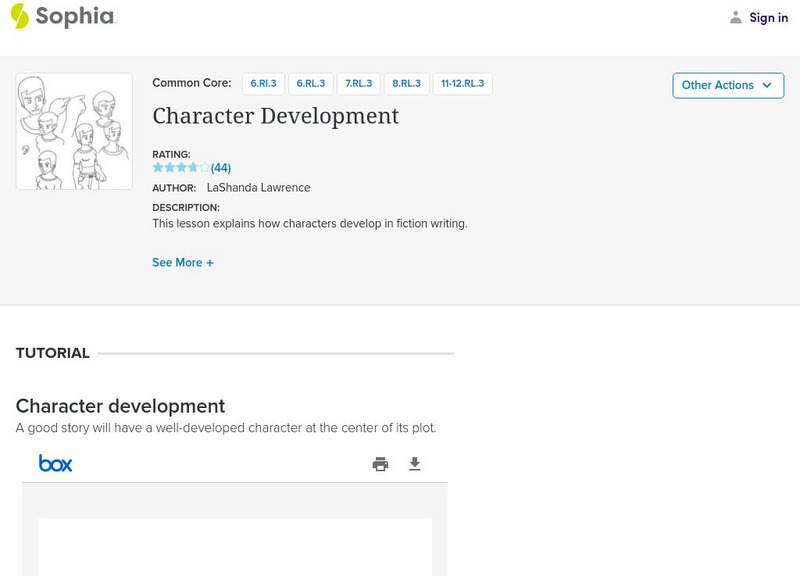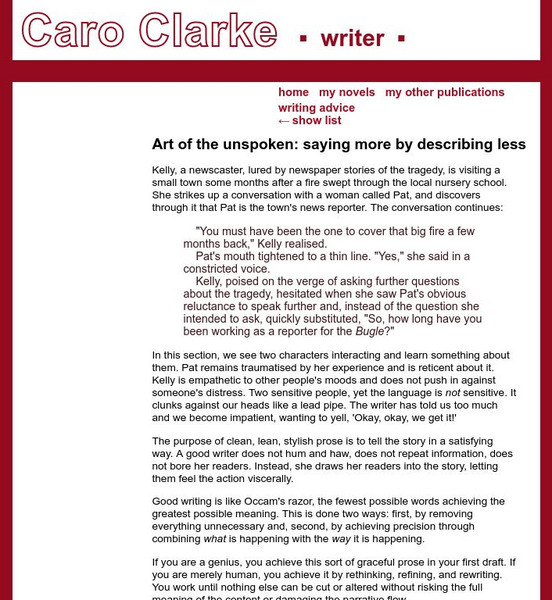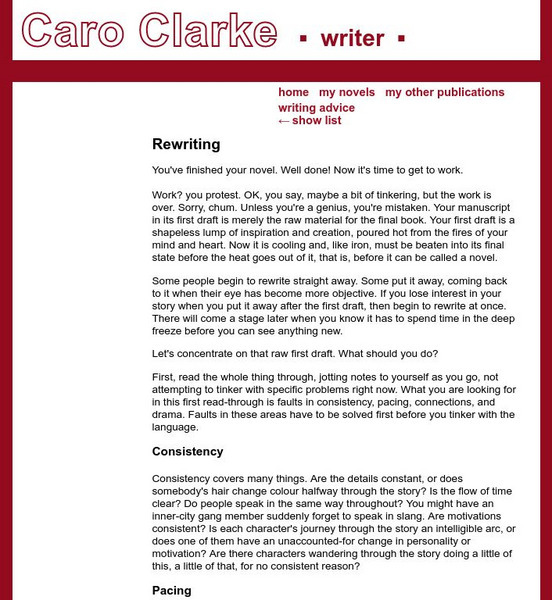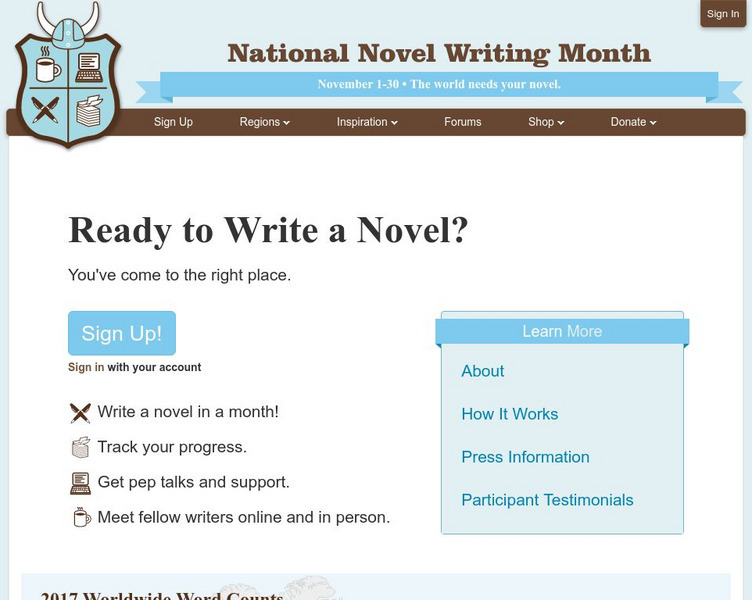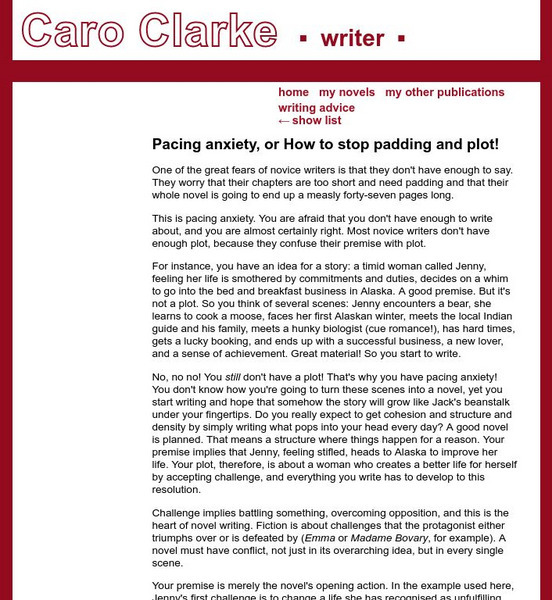Hi, what do you want to do?
E Reading Worksheets
E Reading Worksheets: Story Structure
In this learning module, students will learn more about the structure of a short story. Notes and video clips are provided to reinforce understanding of story structure. This module is designed to support Tier I, Tier II, and Tier III...
E Reading Worksheets
E Reading Worksheets: Narrative Essay Assignments
A number of narrative essay assignments are provided in this discussion. Assignments are provided to help scaffold the narrative essay writing process.
E Reading Worksheets
E Reading Worksheets: Narrative Essay Topics and Story Ideas
A collection of 101 narrative essay topics, short story ideas, and narrative writing prompts are provided on this site. Links to related narrative topics are also provided. W.11-12.3 Narratives, W.11-12.3a Narratives
Sophia Learning
Sophia: Character Development
This lesson explains how characters develop in fiction writing. W.11-12.3d Sensory/precise lang narratives
Other
Write4 kids.com
This site provides a great deal of information on writing children's stories. Contains "Advice, instruction, insider tips, insight and inspiration."
Caro Clarke
Writing Advice: Don't Get It Right the First Time
How much of your novel have you written? Do you keep starting it and never finishing it? Learn the answers to these questions in this novel-writing advice piece.
Caro Clarke
Caro Clarke: What Is Conflict?
This is the sixth in a series of articles designed to help the new writer with their novel. This article focuses on conflict and how it effects the characters and the plot of the story. W.11-12.3a Narratives
Caro Clarke
Not Stopping the Reader: How to Avoid Stumbling Blocks
This is the eighth article in a series that focuses on helping the new novel author. This article looks at how the author can avoid creating stumbling blocks that disrupt the flow of the novel.
Caro Clarke
Explaining Too Much: Why More Is Less
This is the eleventh article in a series that is designed to help the new novel author. This article focuses on how to eliminate needless information in your novel. The key is to not explain too much about the action.
Caro Clarke
The Art of the Unspoken: Saying More by Describing Less
This is the thirteenth article in a series that was developed to help the new novel author. This article focuses on how good descriptions aren't necessarily connected with a lot of words, good descriptions are clean and to the point.
Caro Clarke
Historical Fiction: Who Rules?
This is the fifteenth article in a series designed to help the new novel author. This article focuses on the genre of historical fiction and the role of the author. Is the author a researcher or a story-teller?
Caro Clarke
Rewriting
This is the 17th article in a series that helps the new fiction author with the final step--revision.
Other
National Novel Writing Month
Here's an interesting creative writing challenge. Write a 50,000 word novel between November 1 and November 30. NaNoWriMo has been orchestrating this challenge for several years now and the site has plenty of directions on the process,...
Sophia Learning
Sophia: Characterization
This slideshow focuses on characterization including defining and discussing the 5 methods of characterizations: speech, action, description, interaction, and thoughts with examples of each. It also covers the importance of...
Other
Fiction Writing Tips: Creating a Vivid Setting
Some excellent guidelines to consider when evaluating your setting in a short story or novel. Discusses the importance of setting, some examples, as well as practical advice in setting your story. W.11-12.3d Sensory/precise lang narratives
Caro Clarke
Caro Clarke: Description: What's It For?
This is the twelfth article in a series that is designed to help the new novel writer. This article focuses on how to effectively use descriptions in any writing.
Other
Elements of Fiction
Simple discussion of the elements of fiction with a specific section devoted to Freytag's Pyramid (aka "basic plot structure"). A good place to start for gathering information on the structure of narrative.
Caro Clarke
Writing Advice: Where to Start?
This writing tutorial focuses on helping the aspiring author find a good place to start on his or her fiction.
Caro Clarke
Caro Clarke: Pacing Anxiety, or How to Stop Padding and Plot!
This is the seventh installment of a series giving advice to the author who is new to writing novels. This article focuses on how to take your characters and use them and their conflicts to develop the plot of your story. W.9-10.3b...
Caro Clarke
Caroclarke: Dialogue: The Best Action
This is the fourteenth article in a series published with the goal of helping the new novel author. This article focuses on using dialogue to advance the action of the story. Links on the left offer other information about story writing.
ReadWriteThink
Read Write Think: Making Connections to Myth and Folktale
Excellent online instructional activity based on N. Scott Momaday's The Way to Rainy Mountain. Students create a three-voice narrative based on the novel in studying and learning about myths and folktales. W.9-10.3a,3b,3d,3e Narratives,...
Houghton Mifflin Harcourt
Holt, Rinehart and Winston: Writer's Model: High School Personal Narrative Example
This two-page essay provides an example of a personal narrative (Click on View Printable Version). Clicking on the "Writer's Guide" link in the upper right-hand corner of the page enables the user to get tips, directions, and...
Writing Fix
Writing Fix: Leads for a Most Embarrassing Moment Narrative
Inspired by the embarrassing situation Byron finds himself in during chapter 1 of Christopher Paul Curtis's The Watsons Go to Birmingham - 1963, learners will think of their own embarrassing moments they might write about. Using the...
Writing Fix
Writing Fix: Inventing a New Word
Inspired by the main character's actions in Frindle by Andrew Clements, students will be asked to reinvent an everyday object with a brand new word. They will need to imagine a character has reinvented their word, and then they will...






